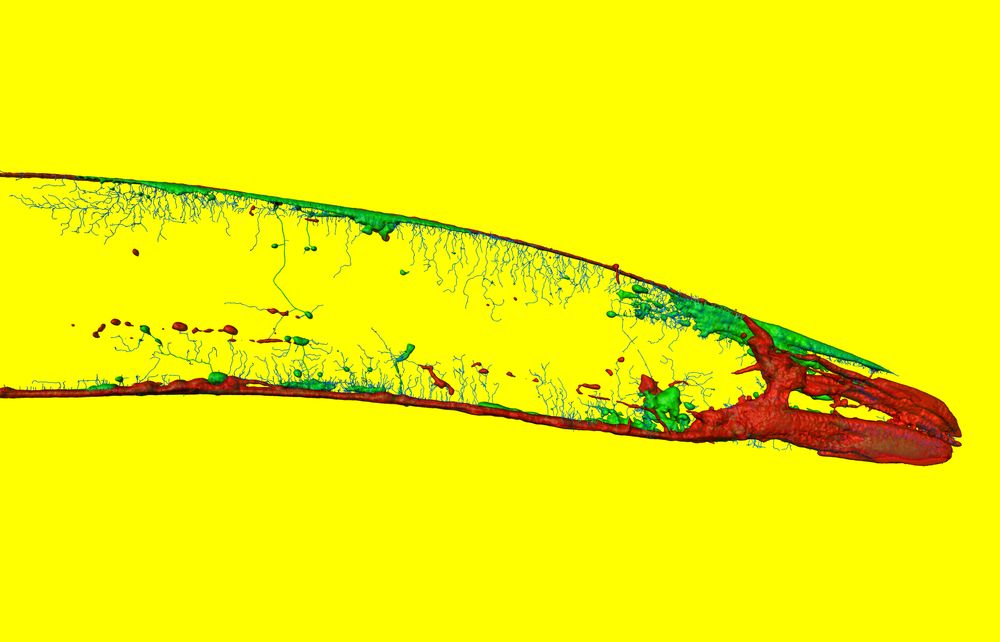
paper here:
academic.oup.com/mbe/article/...
Check my previous, but still up-to-date 🧵 to read the highlights. #TEsky #evosky #Celegans

Selfish genes are found across the tree of life. They can disrupt inheritance patterns and at the same time act as units for molecular innovation. Here we tried to answer one big question: how do selfish genes emerge in the first place?
www.nature.com/articles/s41...

Selfish genes are found across the tree of life. They can disrupt inheritance patterns and at the same time act as units for molecular innovation. Here we tried to answer one big question: how do selfish genes emerge in the first place?
🔗 doi.org/10.1093/molbev/msaf266
#evobio #molbio #TEsky

🔗 doi.org/10.1093/molbev/msaf266
#evobio #molbio #TEsky

Donal O’Carroll and coworkers
www.embopress.org/doi/full/10....

Donal O’Carroll and coworkers
www.embopress.org/doi/full/10....

Our latest work from @immler.bsky.social lab 🐟🧬
Sex-specific responses of small RNAs and transposable elements to thermal stress in zebrafish germ cells
#TESky #TE #piRNA #miRNA #zebrafish #DanioDigest
🔗 Read here www.biorxiv.org/content/10.1...
A thread 🧵...

Our latest work from @immler.bsky.social lab 🐟🧬
Sex-specific responses of small RNAs and transposable elements to thermal stress in zebrafish germ cells
#TESky #TE #piRNA #miRNA #zebrafish #DanioDigest
🔗 Read here www.biorxiv.org/content/10.1...
A thread 🧵...
#TEsky #TEworldwide
authors.elsevier.com/c/1m6MC,LqAZ...
#TEsky #TEworldwide
authors.elsevier.com/c/1m6MC,LqAZ...

Our new study with ~2,000 Z. tritici genomes shows repeated TE mobilization waves during global expansion.
With @danielcroll.bsky.social & @guidopuccetti.bsky.social
🧬 www.nature.com/articles/s41...
#TEworldwide

Our new study with ~2,000 Z. tritici genomes shows repeated TE mobilization waves during global expansion.
With @danielcroll.bsky.social & @guidopuccetti.bsky.social
🧬 www.nature.com/articles/s41...
#TEworldwide
A collaborative effort spanning many years and several labs to uncover what the germline chromosomes of Paramecium really look like. 🔗 www.biorxiv.org/content/10.1...
1/5

A collaborative effort spanning many years and several labs to uncover what the germline chromosomes of Paramecium really look like. 🔗 www.biorxiv.org/content/10.1...
1/5
How do they know when to grow up? Join us at the University of Bristol to find out.
Application deadline Jan 6th
www.findaphd.com/phds/project...
#PlantSciencePhDs @blackinplantsci.bsky.social

How do they know when to grow up? Join us at the University of Bristol to find out.
Application deadline Jan 6th
www.findaphd.com/phds/project...
#PlantSciencePhDs @blackinplantsci.bsky.social
Perfect timing for our paper from the lab of @toddmacfarlan.bsky.social to be out @natcomms.nature.com!!
…and I’m currently on the job market looking for a new scientific home!
www.nature.com/articles/s41...

Perfect timing for our paper from the lab of @toddmacfarlan.bsky.social to be out @natcomms.nature.com!!
…and I’m currently on the job market looking for a new scientific home!
www.nature.com/articles/s41...
The opening remarks by Julius Brennecke accompanied by his fellow scientific organisers:
🔹Déborah Bourc'his
🔹Josefa González
🔹Joseph Peters
#EMBOMobileGenome

The opening remarks by Julius Brennecke accompanied by his fellow scientific organisers:
🔹Déborah Bourc'his
🔹Josefa González
🔹Joseph Peters
#EMBOMobileGenome
We have released #MycoMobilome, a community-focused non-redundant database of transposable element consensus sequences for the fungal kingdom, constructed from >4,000 fungal genomes!
www.biorxiv.org/content/10.1...

We have released #MycoMobilome, a community-focused non-redundant database of transposable element consensus sequences for the fungal kingdom, constructed from >4,000 fungal genomes!
www.biorxiv.org/content/10.1...

Today, we report the discovery of telomerase homologs in a family of antiviral RTs, revealing an unexpected evolutionary origin in bacteria.
www.biorxiv.org/content/10.1...

Today, we report the discovery of telomerase homologs in a family of antiviral RTs, revealing an unexpected evolutionary origin in bacteria.
www.biorxiv.org/content/10.1...

A developmental biologist's developmental biologist, Nobel prize winner
His work is the foundation of much of today's dev & stem cell bio.
An inspiration to many, including me. Always asking questions & wanting the answers
www.magd.cam.ac.uk/news/profess...
A developmental biologist's developmental biologist, Nobel prize winner
His work is the foundation of much of today's dev & stem cell bio.
An inspiration to many, including me. Always asking questions & wanting the answers
www.magd.cam.ac.uk/news/profess...

We produced complete genomes for 2 Xenarthra and placed them in a mammalian comparative framework. We found that Xenarthra harbour the largest number of retrocopies in mammals! www.biorxiv.org/content/10.1...

We produced complete genomes for 2 Xenarthra and placed them in a mammalian comparative framework. We found that Xenarthra harbour the largest number of retrocopies in mammals! www.biorxiv.org/content/10.1...
www.youtube.com/@Workingwith...

www.youtube.com/@Workingwith...
A short thread on how Ectocarpus and its TE secrets have kept me busy lately:
rdcu.be/eITQH
A short thread on how Ectocarpus and its TE secrets have kept me busy lately:
rdcu.be/eITQH


